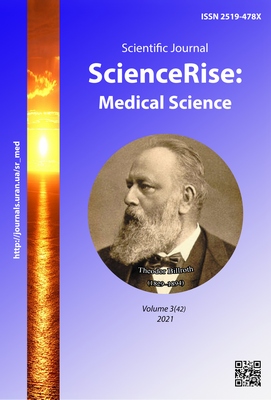Organization of biological materials collection on study of the natural prototype of babesious infection
DOI:
https://doi.org/10.15587/2519-4798.2021.232973Keywords:
mouses rodents, ecotopes, trapping, ectoparasites, babesiosis, natural prototypeAbstract
Ukraine's enzootic in accordance with natural focal diseases including babesiosis, makes the research undertaken relevant.
Aim of the study: to determine the stages in organising the collection of biological materials in the study of the natural prototype of babesiosis.
Materials and methods of research. Objects were murine rodents of Muridae family of genera Myodes, Microtus, Apodemus, Sylvaemus of natural habitats of forest-steppe zone of Ukraine, their ectoparasites-carriers of babesiosis - ticks of family Ixodidae. Collection, accumulation and registration of biological materials was carried out in the conditions of scientific expeditions. Regional geography of them concerned Volyn, Zhytomyr, Kyiv, Poltava, Sumy, Kharkiv, Chernihiv regions of Ukraine.
Results. A total of 63 wild rodents were captured and used in the study. They were adult mice of both sexes, weighing 45-90 g, belonging to the Muridae family, genera Myodes, Microtus, Apodemus, Sylvaemus. Each group of animals gravitated to a specific geographical area of existence with appropriate attributes of flora and fauna. Collection and recording of those on rodent-feeding animals showed that Ixods differ according to phases of development, blood feeding, sex attributes and species affiliation.
Conclusions. Nosological profile of babesiosis as a natural focal obligate-transmissible protozoan blood parasitosis determined methodology of epizootic assessment of area, natural prototype of disease, collection of biological material samples (BMS). BMS collection activities for babesiosis are seasonally dependent. Conducted researches should be focused on 3 links of epizootic or epidemic chain of babesiosis. Invasion by babesia ticks in optimal natural-climatic conditions of development, annual contact with animals led to formation of a latent focus of babesiosis
References
- Villatoro, T., Karp, J. K. (2018). Transfusion-Transmitted Babesiosis. Archives of Pathology & Laboratory Medicine, 143 (1), 130–134. doi: http://doi.org/10.5858/arpa.2017-0250-rs
- Voltsit, O. V. (1999). Biologicheskoe raznoobrazie iksodovykh kleschey i metody ego izucheniya. Moskva: Zoologicheskie issledovaniya, 98.
- Shchorichna dopovid pro stan zdorovia naselennia, sanitarno-epidemichnu sytuatsiiu ta rezultaty diialnosti systemy okhorony zdorovia Ukrainy. 2016 rik (2017). Kyiv: Ministerstvo okhorony zdorovia Ukrainy, DU «Ukrainskyi instytut stratehichnykh doslidzhen», 516.
- Asensi, V., González, L. M., Fernández-Suárez, J., Sevilla, E., Navascués, R. Á., Suárez, M. L. et. al. (2018). A fatal case of Babesia divergens infection in Northwestern Spain. Ticks and Tick-Borne Diseases, 9 (3), 730–734. doi: http://doi.org/10.1016/j.ttbdis.2018.02.018
- Derzhavni sanitarni normy i pravyla "Orhanizatsiia roboty laboratorii pry doslidzhenni materialu, shcho mistyt biolohichni patohenni ahenty I–IV hrup patohennosti molekuliarno-henetychnymy metodamy" (2008). Nakazom Ministerstva okhorony zdorovia Ukrainy No. 26. 24.01.2008. Available at: https://zakon.rada.gov.ua/laws/show/z0088-08#Text
- Yevropeiska konventsiia pro zakhyst khrebetnykh tvaryn, shcho vykorystovuiutsia dlia doslidnytskykh abo inshykh naukovykh tsilei (1986). Verkhovna Rada Ukrainy. 18.03.1986. Available at: https://zakon.rada.gov.ua/laws/show/994_137#Text
- Pro zakhyst tvaryn vid zhorstokoho povodzhennia (2006). Zakon Ukrainy No. 3447-IV. 21.02.2006. Vidomosti Verkhovnoi Rady Ukrainy, 27, 990, st. 230.
- Mizhnarodni rekomendatsii z provedennia biomedychnykh doslidzhen z vykorystanniam tvaryn (1985). Khronyka VOZ, 39 (3), 3–9.
- Torianyk, I. I., Tymchenko, O. M., Ostapets, M. O., Chygyrynska, N. A., Pokhyl, S. I., Kostyria, I. A., Sorokina, I. V. (2020). Use of polymerase chain reaction in verification and differential diagnosis of babesiosis pathogens. Regulatory Mechanisms in Biosystems, 11 (4), 563–567. doi: http://doi.org/10.15421/022087
- Torianyk, I. I. (2021). Biological method for babesiosis detection: the unified version in vivo. Wiadomości Lekarskie, 74 (2), 268–272. doi: http://doi.org/10.36740/wlek202102117
- Halat, V. F., Berezovskyi, A. B., Soroka, N. M., Prus, M. P.; Halat, V. F. (Ed.) (2009). Parazytolohiia ta invaziini khvoroby tvaryn. Kyiv: Urozhai, 368.
- Gray, J. S., Estrada-Peña, A., Zintl, A. (2019). Vectors of Babesiosis. Annual Review of Entomology, 64 (1), 149–165. doi: http://doi.org/10.1146/annurev-ento-011118-111932
- Gazzavi-Rogozinа, L. V., Tkachоv, O. V., Filiptsova, O. V., Naboka, O. I., Burlaka, I. S., Dyomina, Y. V., Pidgaina, V. V. (2018). The method of epizootic assessment of the area of the institute writers. Scientific Messenger of LNU of Veterinary Medicine and Biotechnologies, 20 (83), 36–39. doi: http://doi.org/10.15421/nvlvet8307
- Prihodko, Yu. A., Nikiforova, O. V., Naglov, V. A. (2006), Iksodovie kleshhi (Acarina: Ixodidae)- nositeli i perenoschiki vosbuditeley v severovostochnoy chasti Ukrainy. Parazitologiia v XXI veke: problemy, metody, resheniia. Sankt-Peterburg, 3, 48–53.
Downloads
Published
How to Cite
Issue
Section
License
Copyright (c) 2021 Inna Torianyk

This work is licensed under a Creative Commons Attribution 4.0 International License.
Our journal abides by the Creative Commons CC BY copyright rights and permissions for open access journals.
Authors, who are published in this journal, agree to the following conditions:
1. The authors reserve the right to authorship of the work and pass the first publication right of this work to the journal under the terms of a Creative Commons CC BY, which allows others to freely distribute the published research with the obligatory reference to the authors of the original work and the first publication of the work in this journal.
2. The authors have the right to conclude separate supplement agreements that relate to non-exclusive work distribution in the form in which it has been published by the journal (for example, to upload the work to the online storage of the journal or publish it as part of a monograph), provided that the reference to the first publication of the work in this journal is included.









